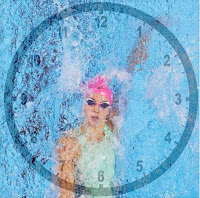Over the last couple of weeks we have spent a lot of time working on our backstroke. We have covered a wide range of topics with this long axis stroke starting of course with our STREAMLINES and UNDERWATER DOLPHIN KICKS, to the breakout, the catch, the rotation and finally the kick.
First off for all you Air Hogs out there you get to swim this stroke with your face out of the water so enjoy breathing.
The first and most important thing we talked about was your body position and how that begins up top with your head and how important it is to hold your head still an d looking straight up. this allows you to keep your hips in alignment and high in the water. If your constantly changing the position of your head your hips start riding that "rollercoaster" creating a lot of drag decreasing efficiency and making you swim slower.
THE CATCH and PULL: We begin the pull with your hand exiting the water thumb-first keeping your arm straight and slowly rotating the body setting up the catch with the pinky entering first. We talked about the clock and how we wasn't to make the catch at the 11 and 1 on the clock. We don't want to enter at the 12. notice the picture on the right. The pull feels similar to a high-elbow freestyle pull.
THE KICK: Think SHORT and FAST here. Kick is driven from the hips not the knees. Toes are pointed and legs not too wide. Smaller and faster kicks will produce more speed. Too slow or no kick and your hips drop creating drag and slower times.
ROTATION: With a small rotation on the catch you reduce shoulder drag and resistance, but be careful not to rotate too much (a little less than in free). Remember Humans are not made to swim in the water efficiently so we are looking for ways to decrease drag and resistance at every opportunity. This should be your focus during training. It may take time but eventually it will produce speed and power. Notice the rotation in the first picture.
TEMPO: Fast backstroke comes down to arm speed and that is challenging for young swimmers because it's hare and uncomfortable, so again we have to work on becoming uncomfortable if we want to swim fast.
Half of the American population does not know how to swim







No comments:
Post a Comment